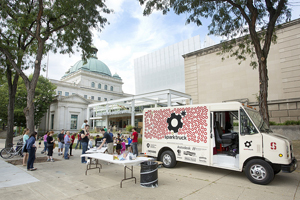
Build a robot using a watch battery, a vibrating pager motor, some tape, and a Popsicle stick.
Those are the instructions Eugene Korsunskiy ’08 gave to groups of fourth graders as he and a team of fellow Stanford Design School students drove coast-to-coast last summer in a redesigned delivery van called SparkTruck. Stopping along the way at schools, science fairs, museums, and libraries, their goal was helping kids learn an essential step in the road to success—failure.
Korsunskiy and his team were charged for their master’s project to “Do anything you want. Make sure it has a positive impact on people. You have a year.” The students had been moved by Sir Ken Robinson’s famous TED talk calling for more creativity in education. “SparkTruck was a response to that call,” Korsunskiy says.
“Creativity happens when you stumble on something that doesn’t feel right, so you poke around and try to make it better,” he says. “That chair is ugly; I will paint it. That tool is clunky; I will design a new one.” Korsunskiy, who studied art at Williams before earning his master of fine arts in design from Stanford in 2012, wanted kids to know it’s OK to poke around.
“You’re much more likely to make something that succeeds if you’re okay with failing several times before you get there,” he says. “If we can instill in kids a resilient mindset—one that prepares them to learn from setbacks rather than be discouraged by them—they are much more likely to persist when tackling complicated problems.”
To fund the project, Korsunskiy and his team ran a campaign on Kickstarter—a fundraising platform in which donor pledges are not collected unless the dollar goal is met. They raised more than $30,000 from 426 backers. It was enough to purchase a used truck and much of the equipment they needed, including a laser cutter, a vinyl cutter, and hand tools. Additional donations came in the form of 3-D printers, and food and lodging expenses were covered by the organizations the team visited. “Sometimes people put us up in their houses,” Korsunskiy says.
In the workshops involving the robot, the children often approached Korsunskiy to ask for his help. He’d respond by asking “What do you think?” and, he says, “It was really cool to see their eyes light up and a gear shift take place in their head as they realized that they were expected to tinker their way to their own solution.”
Now that the SparkTruck team is back in Stanford, Korsunskiy is shifting gears, having accepted a teaching position in the Stanford Design Program. The truck itself may become an ongoing project run by design students.
Whether on the road or in the classroom, Korsunskiy offers this advice on how to keep the creative spark alive: “Stumbling is virtually guaranteed as long as you keep exploring new ideas. So try to fix something broken. You might not get it right the first time, but you’ll learn a lot along the way.”
For more about SparkTruck visit http://sparktruck.org
Megamenu Social